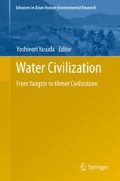Abstract
 Climate deterioration events that started around 4200 and 3200 cal. yr. BP influenced the decline of old world-order civilizations such as Mesopotamia, Egypt, Indus Valley, and Yangtze River. These events triggered large-scale ethnic migrations, which completely reconfigured the world map and thrust the world into a new era. The buds of new world order civilizations started to form, such as the empire of the Han people in China, the Roman Empire in the Mediterranean, and the Preclassic Mayan Civilization in the Central America. During the same period, in the peripheral regions of the Han Dynasty, the Yayoi culture emerged in Japan, the Dian Queendom rose in Yunnan Province, and complex societies were formed along the Mekong in Cambodia. These were rice-cultivating piscatory cultures and distinct from the wheat/barley/millet-cultivating pastoral cultures of the Han and Roman people. The climate abruptly began to ameliorate from 250 BC to 240 AD, when these new world-order civilizations began to flourish. Phum Snay is one of the representative prosperous cities of the new world-ordered civilizations that developed in the peripheral regions of the Han Dynasty, such as Dian Queendom in southern China and Yayoi in Japan.
Climate deterioration events that started around 4200 and 3200 cal. yr. BP influenced the decline of old world-order civilizations such as Mesopotamia, Egypt, Indus Valley, and Yangtze River. These events triggered large-scale ethnic migrations, which completely reconfigured the world map and thrust the world into a new era. The buds of new world order civilizations started to form, such as the empire of the Han people in China, the Roman Empire in the Mediterranean, and the Preclassic Mayan Civilization in the Central America. During the same period, in the peripheral regions of the Han Dynasty, the Yayoi culture emerged in Japan, the Dian Queendom rose in Yunnan Province, and complex societies were formed along the Mekong in Cambodia. These were rice-cultivating piscatory cultures and distinct from the wheat/barley/millet-cultivating pastoral cultures of the Han and Roman people. The climate abruptly began to ameliorate from 250 BC to 240 AD, when these new world-order civilizations began to flourish. Phum Snay is one of the representative prosperous cities of the new world-ordered civilizations that developed in the peripheral regions of the Han Dynasty, such as Dian Queendom in southern China and Yayoi in Japan.
Access this chapter
Tax calculation will be finalised at checkout
Purchases are for personal use only
References
Hieda S, Hirao Y, Kakukawa S (2008) Chemical composition of bronze artifacts unearthed from Phum Snay archaeological site in Cambodia. In: Yasuda Y, Phoeurn C (eds) Preliminary report for the excavation in Phum Snay 2007. International Research Center for Japanese Studies, Kyoto, pp 66–73
Kakukawa S, Hidea S, Hirao Y (2008) Chemical analysis on bronze bracelets unearthed from the Phum Snay archaeological site in Cambodia and the identification of their production. In: Yasuda Y, Phoeurn C (eds) Preliminary report for the excavation in Phum Snay 2007. International Research Center for Japanese Studies, Kyoto, pp 60–65
Matsushita T (2008) Human skeletal remains unearthed from the Phum Snay archaeological site. In: Yasuda Y, Phoeurn C (eds) Preliminary report for the excavation in Phum Snay 2007. International Research Center for Japanese Studies, Kyoto, pp 44–48
Matsushita T, Matsushita M (2011) Human skeletons unearthed from the Phum Snay archaeological site. In: Yasuda Y (ed) Environmental annual history and rise and fall of the rice cultivating and fishing civilization by the study of annually laminated sediments. International Research Center for Japanese Studies, Kyoto, pp 91–119
Miyatsuka Y (2008) Survey and excavation of the Phum Snay archaeological site 2007. In: Yasuda Y, Phoeurn C (eds) Preliminary report for the excavation in Phum Snay 2007. International Research Center for Japanese Studies, Kyoto, pp 1–37
No J, Yamaguchi S, Nishida K, Hirao Y (2011) Scientific study of bronze artifacts excavated from Thailand and Cambodia (for academic year of 2009). In: Yasuda Y (ed) Environmental annual history and rise and fall of the rice cultivating and fishing civilization by the study of annually laminated sediments. International Research Center for Japanese Studies, Kyoto, pp 124–150
Sakaguchi Y (1984) Nihon no senshi rekishijidai no kikou (Climate change at prehistoric and historic periods in Japan). Shizen 5, Chûôkôronsha, Tokyo (in Japanese)
Yasuda Y (1987) Palaeoenvironment of the Sombo site in Fukui Prefecture, Central Japan: a study of the climatic deterioration in the Kofun era. Sci Rep Facul Integr Arts Sci Hiroshima Univ ser. iv, 12:11–38
Yasuda Y (2009) Inasaku gyorô bunmei (The rice-cultivating piscatory civilization). Yûzankaku, Tokyo, 386 pp
Yasuda Y (ed) (2011) Environmental annual history and rise and fall of the rice cultivating and fishing civilization by the study of annually laminated sediments. International Research Center for Japanese Studies, Kyoto, 170 pp
Yasuda Y, Phoeurn C (eds) (2008) Preliminary report for the excavation in Phum Snay 2007. International Research Center for Japanese Studies, Kyoto, 73 pp
Author information
Authors and Affiliations
Editor information
Editors and Affiliations
Rights and permissions
Copyright information
© 2013 Springer Japan
About this chapter
Cite this chapter
Yasuda, Y. (2013). Phum Snay and Its Significance in World History. In: Yasuda, Y. (eds) Water Civilization. Advances in Asian Human-Environmental Research. Springer, Tokyo. https://doi.org/10.1007/978-4-431-54111-0_9
Download citation
DOI: https://doi.org/10.1007/978-4-431-54111-0_9
Published:
Publisher Name: Springer, Tokyo
Print ISBN: 978-4-431-54110-3
Online ISBN: 978-4-431-54111-0
eBook Packages: Earth and Environmental ScienceEarth and Environmental Science (R0)

